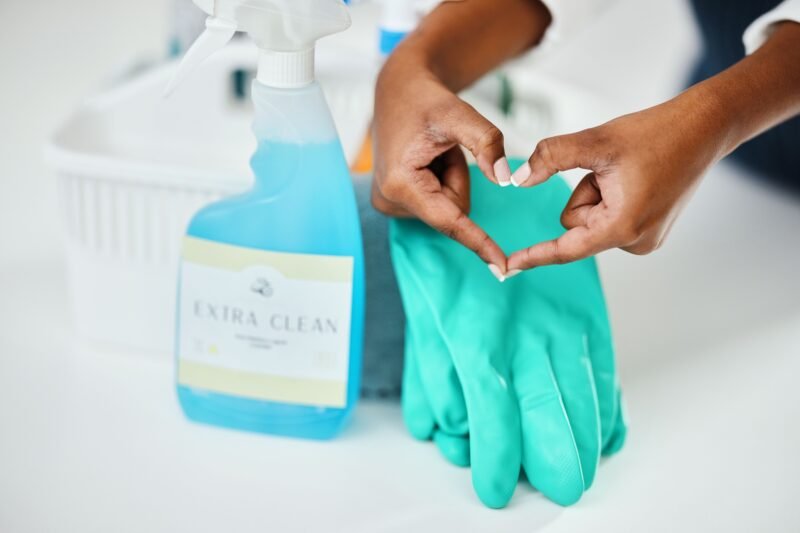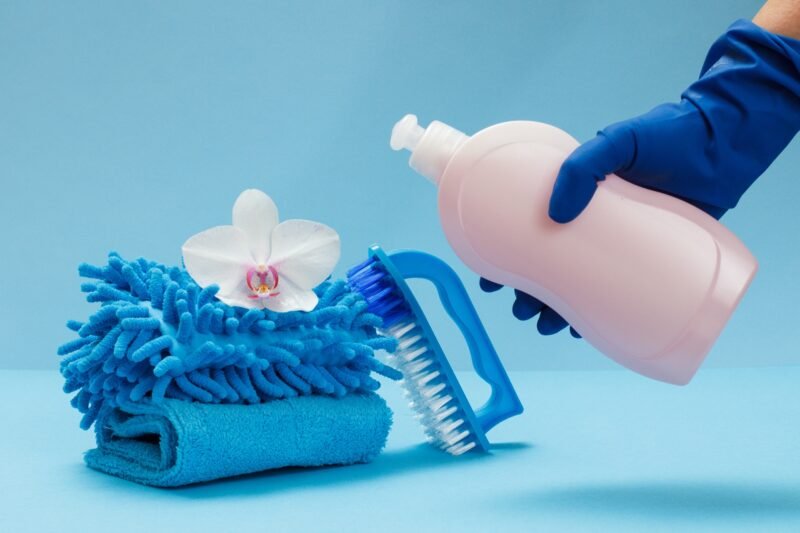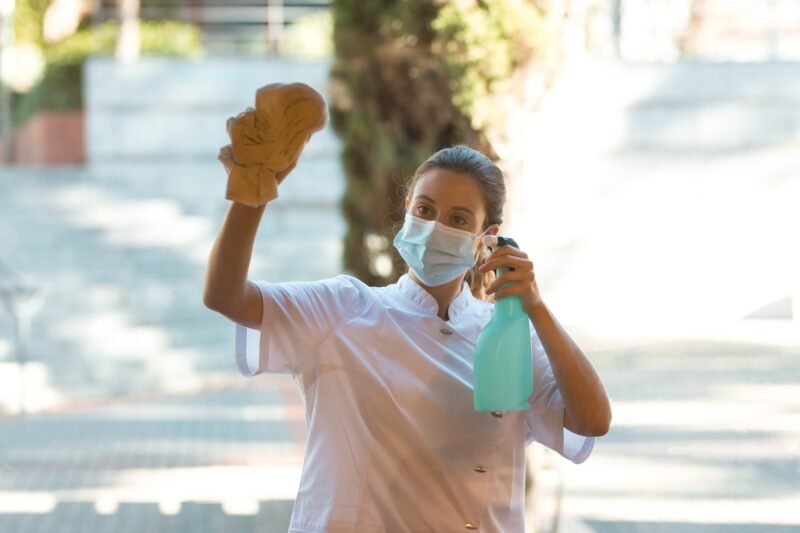How to Maintain Your Pickleball Paddle: Cleaning, Storage & Grip Tips
Prefer to listen? Tap play below!
Essential Pickleball Paddle Maintenance Tips for Longevity and Performance
Pickleball has boomed. There are over 4.8 million players in the USA according to the Sports & Fitness Industry Association. With the increased demand for this fabulous sport, the pickleball paddle market has exploded. It is important that you know how to care for your pickleball paddle. This guide offers the best tips to get you going.
It’s easy-peasy. Clean your pickleball paddle! Spray it with water and wipe it down with your kitchen dishcloth. It doesn’t take long and it will look fantastic after every game. Don’t go using industrial-strength cleaner or a wire brush, but a little soap and water won’t hurt it. Stick to a damp cloth. Remember, if it’s dirty, scratchy, or sweaty, your paddle is not going to be happy.

Heart hands, cleaning and chemical detergent bottle, closeup of supplies and cleaner with hygiene
Inspect it from time to time. Arms, thumbs, hands, and fingers. A bit of binding to the graphics. A plastic guide down the edge. The handle. Cleaning it all will be easy. If they need a repair, fix them early before it becomes a bigger problem.
And finally, store it the right way. A cover, a bag, a pickleball glove, or something. Have something around it. Don’t leave your paddle in a hot sweaty car. In the worst case, you’ll have to replace the paddle (hopefully not periodically).
Types of Pickleball Paddles and Their Materials
The material of which your paddle is made can have a huge impact on not just how it performs, but how you maintain it too. There are three common types: wood, composite, and graphite. Knowing about these materials is crucial for a proper maintenance plan.
Wood paddles are relatively cheap to buy, hence why they are a go-to choice for new players. They’re safe from damage, as they can take care of themselves, but not so safe from the maintenance list. Wood is capable of soaking in any moisture leaving it exposed to possible warping or cracking. In that vein, always monitor for any damages on them. The most common sign of wear initially is small creases or folds in the wood layers. They should be kept in a dry place. If they’ve been exposed to sweat or dirt, wipe them clean.
Composite paddles are typically for intermediate players since they are used to find a nice balance between power and lightweight counter-play options. Be aware of where you’re storing all of your equipment, it’s never a good idea to expose it to extreme levels of heat or cold.
Graphite paddles are usually for more skilled players. Having this paddle will certainly impress a lot of people, but take care not to chip and crack your paddle. Make sure to take good care of these paddles, don’t bash them against anything!
Daily and Weekly Pickleball Paddle Upkeep
Regular inspections of your pickleball paddle are essential for maintaining its performance and longevity. Just like any sports equipment, paddles are subject to wear and tear from frequent use. To ensure optimal performance, it is advisable to check your paddle for signs of damage or deterioration after every few sessions. This proactive approach can help you identify minor issues before they escalate into major problems, ultimately saving you time and money.
One of the key aspects of pickleball paddle upkeep is to look for visible signs of wear, such as cracks, chips, or delamination. These issues can significantly affect your paddle’s performance, leading to inconsistent shots and reduced power. By inspecting your paddle regularly, you can catch these problems early and either repair or replace the paddle as needed. This not only enhances your game but also ensures that you are playing safely, as a damaged paddle can lead to injury.

In addition to visual inspections, it is also important to assess the grip of your paddle. Over time, the grip can wear down, making it difficult to hold the paddle securely during play. A slippery grip can lead to mishandling and poor shot execution. Checking the grip regularly and replacing it when necessary is a crucial part of paddle maintenance that can greatly improve your overall playing experience.
Another factor to consider is the environmental conditions in which you play. Exposure to extreme temperatures, humidity, or direct sunlight can accelerate the wear and tear on your paddle. If you frequently play outdoors, it is wise to inspect your paddle more often, as these conditions can lead to quicker degradation. Storing your paddle in a protective case when not in use can also help mitigate damage from environmental factors.
Ultimately, the frequency of inspections should be tailored to your level of play and the conditions in which you use your paddle. For casual players, checking for wear and tear every few weeks may suffice, while more competitive players might benefit from weekly inspections. By prioritizing regular paddle upkeep, you can ensure that your equipment remains in top condition, allowing you to focus on improving your skills and enjoying the game.
How to Properly Clean Your Pickleball Paddle
It’s important to clean your pickleball paddle to keep it in good playing condition. You might be surprised by how much dirt, grime, and sweat can accumulate on your pickleball paddle. A clean pickleball paddle plays better, so this is a good way to enhance your game and get more life out of the equipment that you’re likely to have spent a lot of money on.
To get started with cleaning, you will need a soft, clean cloth; dishwashing soap or a paddle-specific cleaning solution; and some warm water. Do not use anything that’s too hardcore, like strong cleaning chemicals or harsh cleaning materials, as these can potentially harm your paddle. Get the water lukewarm, and use a small amount of the cleaning solution in combination with the water to get the best results. Dip the cloth into the cleaning solution and give your paddle a good rub. You should wipe the paddle dry immediately afterward. You don’t want the water to drip into the paddle material as a result of not properly drying it out. Failure to do so may cause the paddle material to deteriorate.
Don’t skip the add-ons! Pickleball paddle-specific cleaners contain special ingredients to condition the surface that can help extend the life of the paddle. Look for ones that are zinc color, pH-balanced, and have sturdy, soft sponges. Get those tough-to-clean surface playing spots. Look for a soft sponge that’s not too abrasive but that has ridges in it to store some soap so that you can scrub out those hard to reach spots.
Shine your game up! A clean paddle plays better, so this is a good way to enhance your game and get more life out of the equipment. This is also important for two other reasons. First, a paddle likely to have lost its shine is more likely to release the ball less crisply. This means more pickleballs hit into the net, and more likely to make a bad sound (broken sound) upon ball contact. And perhaps most importantly, a less-shiny paddle lets savvy opponents know that you aren’t yet “sophisticated” enough in the sport to actually care about paddle maintenance. For this reason, those less-shiny paddles are tells for more experienced players to target you.

Cleaning lady using a face mask while cleaning the window. New normal lifestyle. Cleaning and hygiene concept.
DIY Pickleball Paddle Repair Tips
If you play pickleball, you’ll eventually need to understand the art of pickleball paddle repair, or at least be familiar with some frequent problems that can develop with paddles:
Surface Scratches: This is THE most common issue. Why? It’s because we whack a ball with these paddles all day long, and sometimes that ball is bouncing off a very hard surface. Despite pickleball manufacturers’ best efforts, scratches are almost inevitable. How do you repair scratches? Well, the answer to that depends on your paddle and the maker because the construction varies from paddle to paddle. However, the short answer is, if the problem is purely cosmetic, just grab a very fine piece of sandpaper and work down your paddle. Make sure to let the manufacturer know if you feel it’s highly unusual. If the scratch is quite deep, you should let your paddle manufacturer know and see what they recommend.
Loose Grip or Handle: Have you ever noticed that your paddle’s handle looks a little different? Maybe the grip is separating; maybe the whole handle feels like it is wiggling? If so, then you have a problem, and I have some solutions for you! Actually, this is quite a common pickleball problem. The grips on pickleball paddles are attached with adhesive, and after much use, that adhesive can sometimes let go. What do you do? Well, the straightforward answer is that you should get the paddle manufacturer to repair it unless it is a really easy problem to fix like replacing the grip tape.
Best Practices for Storing Your Paddle
The way you store your pickleball paddle directly relates to its overall life and condition. No matter what kind of paddle you own, those pieces of sports equipment are specifically built to only take abuse in the right way. Extreme heat will warp the fragile parts while excessive moisture will invite mold and deterioration. Below is a list of how to properly care for your pickleball paddle when it is not in use:
- The best temperature to store your pickleball paddle is in a cool, dry place. Ideally, a nice room-temperature location with a touch of airflow that’s located someplace in the middle of 60°F and 80°F.
- The paddle shouldn’t be stored in a hot car or directly next to a heating vent. Not only will the excessive heat warp the paddle due to loosened adhesive, but I’m sure the material will start to deteriorate. If it’s too cold, that’s bad as well. Materials become brittle and are easier to break while cold.
- Avoid high humidity conditions where a wooden or composite pickleball paddle will act like a sponge, soaking up as much moisture as possible only to either mold or become damaged/swollen as a result.
- If the paddle is not in use, use a case, because cases usually have room for more than one paddle. Cases are rather helpful for more than one reason: 1) they provide over-the-top protection in the form of padding, 2) they help regulate their own temperature (what you store in them will take a longer time to either cool or heat up), and 3) you can stay organized by having your pickleball paddle accessories in their designated compartments!
Some of the key maintenance points to note will be:
- You should rinse and wipe your paddle with water after every session.
- Put the paddle aside and look out for any visible damage.
- Make sure you find a safe personal spot for the paddle.
By doing this, you’re going to extend the lifespan of the paddle. If you’re a beginner, start off on the right path in choosing the right paddle.
Other Articles
Pickleball Drills to Improve Net Play
Pickleball Tournament Prep Checklist
Pickleball Tips for Playing Indoors
Pickleball Drills for Better Reaction Time
How to Build a Backyard Pickleball Court
Pickleball Strategy for Windy Conditions
Pickleball Paddle Grip Techniques
Improve Pickleball Serve Accuracy
Pickleball Doubles Positioning Tips

